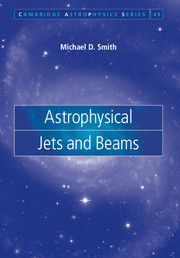Book contents
- Frontmatter
- Contents
- Preface
- 1 Introduction
- 2 Detection and measurement
- 3 The dynamical toolbox
- 4 Observations of extragalactic jets
- 5 Jets in galactic nuclei
- 6 Jets from young stars and protostars
- 7 Jets associated with evolved stars
- 8 Jets within the solar system
- 9 Jet launching
- 10 Jet propagation
- 11 The astrophysical jet
- References
- Index
2 - Detection and measurement
Published online by Cambridge University Press: 05 March 2012
- Frontmatter
- Contents
- Preface
- 1 Introduction
- 2 Detection and measurement
- 3 The dynamical toolbox
- 4 Observations of extragalactic jets
- 5 Jets in galactic nuclei
- 6 Jets from young stars and protostars
- 7 Jets associated with evolved stars
- 8 Jets within the solar system
- 9 Jet launching
- 10 Jet propagation
- 11 The astrophysical jet
- References
- Index
Summary
The material contained in the jet is the first property to ascertain. Almost all our information is derived from distant observation. We can only hope to send probes to rendezvous with comets and possibly intercept their jets. Further afield, we rely upon the radiation that reaches us. Therefore, a chapter to outline the radiative properties is a necessity to interface observations with the physical structure.
The evidence is accumulated across the electromagnetic spectrum providing a bank of line strengths and continuum fluxes. These continuum values yield the spectral shape, perhaps a power law with excess emission in the form of broad bumps. The specific wavelengths of the line fluxes can often be confidently identified with the generating atoms or molecules, and the ratios of fluxes may directly yield the particle states. Here, we introduce the major radiation processes to which matter in various states is subject. In the chapters which follow, we may then work backwards to relate the spectral properties to the gas which would produce it.
That, however, is only half the story. We must still question whether or not we are detecting the jet itself. Instead, it may merely be the excited interface with ambient gas or it could be a minor component of the jet. In fact, we often detect just a few discrete regions where the density or temperature has been temporarily enhanced. This can be misleading, since these regions are atypical of the underlying continuous flow which has produced them. This has remained highly problematic for extragalactic jets where we only observe the effects of the relativistic electrons and magnetic field.
- Type
- Chapter
- Information
- Astrophysical Jets and Beams , pp. 16 - 28Publisher: Cambridge University PressPrint publication year: 2012

